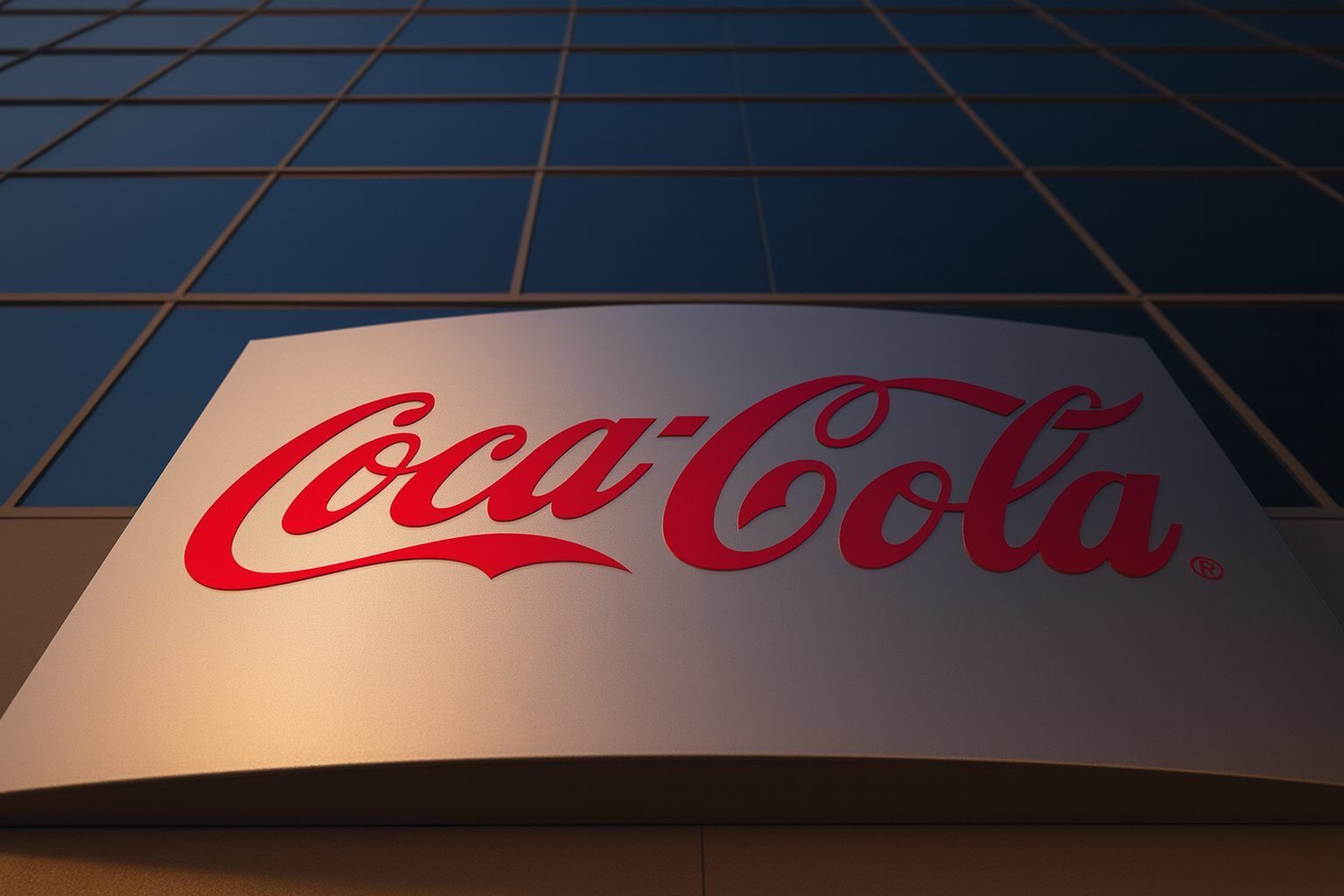As markets head into the Tuesday, November 25, 2025 session, Coca-Cola Company (The) stock (NYSE: KO) is trading in classic “steady blue‑chip” fashion: modest price moves, strong dividend support, and quietly improving fundamentals.
As of the close on Monday, November 24, KO finished at $72.59, down about 0.5% on the day but still up roughly 13–14% over the last 12 months and trading well above both its 50‑day and 200‑day moving averages. [1] Over the past year, the stock has moved in a range of roughly $60–$74, leaving it nearer the upper half of that band as investors position for year‑end. [2]
Below is a roundup of the latest price action, fundamentals and news investors are watching around KO as of late November 24, 2025, relevant for trading and investing decisions on November 25.
Key takeaways for KO stock today
- Price and trend: KO closed at $72.59 on November 24, 2025, with after‑hours trading nudging the price slightly lower around $72.53. The stock sits comfortably above its 50‑day (~$68.5) and 200‑day (~$69.8) moving averages, and is up about 13.5% over the last year, signaling a constructive technical backdrop heading into November 25. [3]
- Defensive blue‑chip profile: With a beta around 0.40, KO continues to behave as a lower‑volatility name versus the broader U.S. equity market, a typical trait of consumer‑staples giants. [4]
- Dividend strength: Coca-Cola currently pays an annual dividend of $2.04 per share (about $0.51 per quarter), for a yield near 2.8% at current prices, and has increased its dividend for 63 consecutive years. [5] The next ex‑dividend date is December 1, 2025, with payment scheduled for December 15, 2025. [6]
- Fundamentals after Q3 2025: In the third quarter of 2025, Coca‑Cola grew net revenue by 5%, organic revenue by 6%, and unit case volume by 1%, while expanding operating margin to about 32% and lifting EPS by 30% to $0.86 versus the prior year, largely thanks to pricing power and mix. [7]
- Valuation: KO trades at a trailing P/E near 24x earnings and a forward P/E around 22–23x, with a price‑to‑sales ratio around 6.6x and price‑to‑book just under 10x — a clear “quality premium” versus the wider market. [8]
- Analyst view: According to aggregated data, the average 12‑month price target is about $78.15 per share — roughly 7–8% upside from current levels — with a “Strong Buy” consensus rating from 13 analysts and mid‑single‑digit revenue plus double‑digit EPS growth forecasts over the next five years. [9]
- Latest news flow: Recent coverage focuses on (1) KO’s Q3 earnings beat and margin expansion, [10] (2) a system‑wide refranchising move in Africa involving bottler Coca‑Cola HBC, [11] (3) brand initiatives such as nostalgia‑driven flavors, [12] and (4) institutional buying alongside some insider selling. [13]
KO stock price heading into November 25, 2025
On Monday, November 24, Coca‑Cola shares:
- Opened: around $73.16
- Traded in a range: roughly $71.6 – $73.2 during the regular session
- Closed: at $72.59, on volume of about 18.7 million shares in regular hours, slightly above the recent 20‑day average. [14]
After the bell, KO ticked down modestly in after‑hours trading to around $72.53 as of 6:15 p.m. EST. [15]
Despite Monday’s small pullback, KO remains in an upward one‑year trend, with the stock:
- Up roughly 13–14% over the last 52 weeks,
- Trading above its 50‑day and 200‑day moving averages, a pattern many technicians view as supportive for bulls. [16]
In the broader beverage space, Monday’s session saw KO modestly lag high‑growth competitor Monster Beverage, which climbed about 1.7% to a new 52‑week high, while KO slipped roughly 0.5% and the S&P 500 gained more than 1.5%. [17] That’s a reminder that Coca‑Cola tends to trade more like a defensive dividend name than a momentum stock.
At the time of writing, there are no KO‑specific company press releases dated November 25, 2025 yet; the market is still digesting the Q3 results and late‑October/November strategic updates described below. [18]
Fundamentals after Q3 2025: pricing power on display
Coca‑Cola’s third‑quarter 2025 results, released on October 21, set the tone for how investors are viewing KO into year‑end. [19] Key highlights:
- Revenue & volume:
- Net revenue grew 5% to roughly $12.5 billion, while organic revenue (which strips out currency and structural items) rose 6%.
- Global unit case volume increased 1%, showing that modest volume growth plus strong pricing is still working. [20]
- Pricing & mix:
- Price/mix improved by about 6%, meaning Coca‑Cola is successfully charging more and nudging consumers into higher‑value products without materially damaging volumes. [21]
- Margins & profits:
- Operating margin jumped to about 32%, up sharply from the prior‑year quarter (low‑20s%), thanks to higher prices and cost discipline.
- EPS climbed 30% to $0.86 (GAAP), while comparable EPS increased around 6% after adjusting for certain items and currency headwinds. [22]
- Category performance:
- Overall soda volumes were essentially flat, but Coca‑Cola Zero Sugar delivered double‑digit growth.
- Water, sports drinks, coffee and tea together grew around 3%, while juice, value‑added dairy and plant‑based beverages slipped by a similar amount — reflecting shifting consumer preferences. [23]
Management reaffirmed confidence in hitting its full‑year guidance for mid‑single‑digit organic revenue growth and high‑single‑digit EPS growth in 2025, signaling that the company believes its pricing and premiumisation strategy still has room to run. [24]
For KO shareholders looking at November 25, the key takeaway is that earnings momentum is being driven more by pricing and mix than by big volume expansion — classic for a mature consumer‑staples leader.
Strategic moves in the Coca‑Cola system
Coca‑Cola’s value creation isn’t just about the KO ticker; it also reflects the performance of its global bottling partners and brand strategy.
Africa refranchising with Coca‑Cola HBC
As highlighted in the Q3 release, Coca‑Cola agreed to sell a controlling stake in Coca‑Cola Beverages Africa (CCBA) to its bottling partner Coca‑Cola HBC in a deal valuing CCBA at about $3.4 billion. [25]
Under the transaction:
- Coca‑Cola HBC will acquire Coca‑Cola’s roughly 42% stake plus the Gutsche family’s holding, ending up with 75% of CCBA.
- Coca‑Cola HBC will have an option to buy the remaining 25% over time. [26]
For KO investors, this fits a long‑running “asset‑light” strategy: focus on concentrate brands and marketing while shifting capital‑intensive bottling to partners. Over time, that can support higher margins and more stable cash flows, even if it slows headline revenue growth.
Europe: transition from Nestea to Fuze Tea
On the bottling side in Europe, Coca‑Cola Europacific Partners reported that Q3 volumes in Spain slipped due to the transition from the Nestea brand to its own Fuze Tea, though Iberian revenues still rose about 1.3% thanks to price increases. Globally, the bottler grew Q3 revenue about 1% and maintained a forecast of 3–4% revenue and 7% operating profit growth for 2025. [27]
Again, the pattern is familiar: pricing and premium products offset softer volumes, which is supportive for KO’s concentrate business and brand equity.
Brand innovation: nostalgia and “Creations” as subtle stock catalysts
Beyond the numbers, recent coverage has spotlighted Coca‑Cola’s nostalgia‑driven product strategy as a quiet but meaningful driver of demand.
An analysis from AInvest noted: [28]
- Limited‑time nostalgic flavors such as Coca‑Cola Orange Cream (launched in early 2025) generated roughly $50 million in Q1 retail sales, underscoring how retro flavors can unlock incremental revenue.
- A broader Coca‑Cola Creations program — spanning limited‑edition flavors and collaborations — is helping the company test concepts quickly while keeping the core brand front‑and‑center.
- This innovation has contributed to a share price increase of roughly 15% year‑to‑date by November 2025, according to that analysis, with some DCF models suggesting fair value well above the current market price.
While any single limited‑edition flavor is small in the context of a $300‑plus‑billion company, the strategic point is important: Coca‑Cola is using nostalgia, local tailoring and premium positioning to keep the brand culturally relevant, which supports pricing power — a key ingredient in KO’s investment case.
Dividend snapshot: why income investors still care about KO
For many investors considering KO on November 25, the dividend is the main attraction.
From current data:
- Annual dividend: about $2.04 per share, paid quarterly (roughly $0.51 per share each quarter). [29]
- Dividend yield: approximately 2.8% at the recent price. [30]
- Streak: Coca‑Cola has raised its dividend for 63 straight years, placing it firmly among the U.S. “Dividend Aristocrats.” [31]
- Payout ratio: around 68% of earnings, with a free‑cash‑flow yield below 2%, implying that while the dividend is well‑covered, growth in the payout will likely track earnings rather than explode higher. [32]
Near term, the key date is the December 1, 2025 ex‑dividend date: investors who own KO before that date (subject to settlement rules with their broker) are eligible to receive the December 15 payout. [33] This timing often attracts short‑term “dividend capture” interest and can influence trading around late November and early December.
For income‑focused investors, KO’s appeal rests on:
- A reliable, slowly rising dividend,
- Lower‑than‑market volatility, and
- A business model that historically weathers economic cycles better than many sectors.
Valuation today: quality at a premium price
From a valuation standpoint heading into November 25, KO looks like a classic quality‑at‑a‑premium story rather than a bargain‑bin value play.
Based on recent statistics: [34]
- Trailing P/E: ~24x
- Forward P/E: ~22.7x
- Price‑to‑sales: ~6.6x
- Price‑to‑book: ~10x
- EV/EBITDA: ~21x
Analysts expect: [35]
- Roughly 3–4% annual revenue growth over the next several years
- Around 10–11% annual EPS growth, helped by margin expansion and buybacks
- A consensus fair value in the high‑$70s per share, with some models pointing to the upper‑$70s or low‑$80s and a few DCF‑based views even higher
For prospective shareholders, the implied total‑return math (if forecasts prove roughly correct) looks something like:
- ~2.8% from dividends, plus
- Mid‑ to high‑single‑digit EPS growth,
- Upside (or downside) depending on whether the market keeps paying mid‑20s P/E for KO.
That suggests a potential long‑term annual return in the mid‑single‑ to low‑double‑digit range, but primarily driven by fundamentals, not multiple expansion.
Institutional buying, insider selling: how meaningful is it?
Recent filings show Global Retirement Partners LLC established a new stake in KO, acquiring about 116,823 shares, valued near $8.3 million based on its latest 13F. [36] Other institutions have also modestly increased positions, contributing to institutional ownership above 65% of shares outstanding. [37]
At the same time, recent disclosures highlight that:
- COO Henrique Braun sold roughly 40,000 shares earlier in November,
- EVP Monica Howard Douglas sold more than 13,000 shares in October,
- In total, insiders sold around 225,000 shares over the past three months, worth nearly $16 million. [38]
Insider selling at a mature mega‑cap like KO is not unusual — executives frequently diversify or exercise options — but it does slightly temper the otherwise bullish message from institutional accumulation.
Analyst and commentary round‑up
Several recent pieces of commentary shed light on how the market is framing KO right now:
- Analyst optimism and dividend narrative: A recent Simply Wall St piece highlighted how high‑profile analyst endorsements and KO’s long dividend track record are shaping the current narrative more than short‑term operational details. It points to projected revenue of about $55 billion and earnings of $14.8 billion by 2028, implying steady mid‑single‑digit top‑line growth and a fair value near $77–78 per share. [39]
- Long‑term earnings power: Coverage on Nasdaq noted that analysts see Coca‑Cola adding over $1 billion in net income annually over the next several years, potentially lifting adjusted EPS roughly 40% between 2025 and 2030 — a key driver for the bullish “slow and steady” total‑return story. [40]
- Dividend‑first logic: Multiple outlets continue to position KO as a core dividend holding rather than a high‑growth play, emphasizing its decades‑long income track record and resilience across economic cycles. [41]
Collectively, these views align on a central theme: KO is unlikely to be a rocket ship, but it remains a favored compounder for patient income‑oriented investors.
Key risks and what to watch on November 25, 2025
Even with its defensive reputation, Coca‑Cola faces several risks that matter for anyone trading or investing around November 25:
- Health and regulatory pressure
- Governments continue to experiment with sugar taxes, labeling rules and health campaigns, which can weigh on soda volumes and push consumers toward lower‑sugar options.
- The Q3 breakdown already shows growth skewing toward water, sports drinks and zero‑sugar offerings, while traditional juices and some sparkling flavors are under pressure. [42]
- Competition in “better‑for‑you” beverages
- Analysts and commentators have flagged heightened competition in functional and health‑oriented drinks as a key challenge, particularly as Coca‑Cola reassesses its position in coffee (e.g., around the Costa Coffee business). [43]
- FX and emerging‑market exposure
- A large share of KO’s sales and volume comes from outside North America, so currency swings and macro volatility can impact reported results, even when local trends are healthy. [44]
- Valuation risk
- Trading at around 24x trailing earnings, KO already commands a premium valuation. If investor appetite for defensive staples cools — for example, if interest rates stay elevated or growth sectors regain dominance — the multiple could compress, limiting returns even if earnings keep rising. [45]
For Tuesday, November 25 specifically, short‑term traders will likely watch:
- Whether KO can hold above the $70–$71 zone, which roughly corresponds to its 50‑ and 200‑day moving averages and prior consolidation levels. [46]
- Flows around year‑end positioning and the upcoming December ex‑dividend date, which can draw in both income investors and short‑term dividend traders. [47]
Bottom line: how KO looks going into November 25, 2025
Putting it all together:
- From a fundamental perspective, Coca‑Cola is delivering exactly what most shareholders expect: modest volume growth, strong pricing power, expanding margins and a reliable dividend, backed by an asset‑light system and powerful global brands. [48]
- From a valuation perspective, KO is not cheap, but its premium appears broadly in line with its stability, cash‑flow profile and analyst expectations for mid‑single‑digit revenue and high‑single‑digit to low‑double‑digit EPS growth. [49]
- From a news‑flow perspective, the focus is on Q3 execution, the African bottling transaction, nostalgia‑driven innovation, and the upcoming dividend — rather than any one dramatic catalyst on November 25 itself. [50]
For long‑term, income‑oriented investors, KO heading into November 25, 2025 looks like a familiar proposition: a defensive compounder with a dependable dividend and reasonable (if unspectacular) growth prospects, trading at a quality premium.
For short‑term traders, the story is more about technical levels, sentiment around defensive stocks, and the approach of the December ex‑dividend date than about new company‑specific announcements.
Important note: This article is for information and education only and does not constitute financial advice, investment recommendation, or a solicitation to buy or sell any security. Always do your own research or consult a licensed financial professional before making investment decisions.
References
1. stockanalysis.com, 2. www.marketbeat.com, 3. stockanalysis.com, 4. stockanalysis.com, 5. stockanalysis.com, 6. investors.coca-colacompany.com, 7. investors.coca-colacompany.com, 8. stockanalysis.com, 9. stockanalysis.com, 10. investors.coca-colacompany.com, 11. investors.coca-colacompany.com, 12. www.ainvest.com, 13. www.marketbeat.com, 14. finance.yahoo.com, 15. stockanalysis.com, 16. stockanalysis.com, 17. www.marketwatch.com, 18. investors.coca-colacompany.com, 19. investors.coca-colacompany.com, 20. investors.coca-colacompany.com, 21. investors.coca-colacompany.com, 22. investors.coca-colacompany.com, 23. investors.coca-colacompany.com, 24. investors.coca-colacompany.com, 25. investors.coca-colacompany.com, 26. www.reuters.com, 27. cincodias.elpais.com, 28. www.ainvest.com, 29. stockanalysis.com, 30. stockanalysis.com, 31. stockanalysis.com, 32. stockanalysis.com, 33. investors.coca-colacompany.com, 34. stockanalysis.com, 35. stockanalysis.com, 36. www.marketbeat.com, 37. stockanalysis.com, 38. www.marketbeat.com, 39. simplywall.st, 40. www.nasdaq.com, 41. stockanalysis.com, 42. investors.coca-colacompany.com, 43. simplywall.st, 44. investors.coca-colacompany.com, 45. stockanalysis.com, 46. stockanalysis.com, 47. investors.coca-colacompany.com, 48. investors.coca-colacompany.com, 49. stockanalysis.com, 50. investors.coca-colacompany.com








